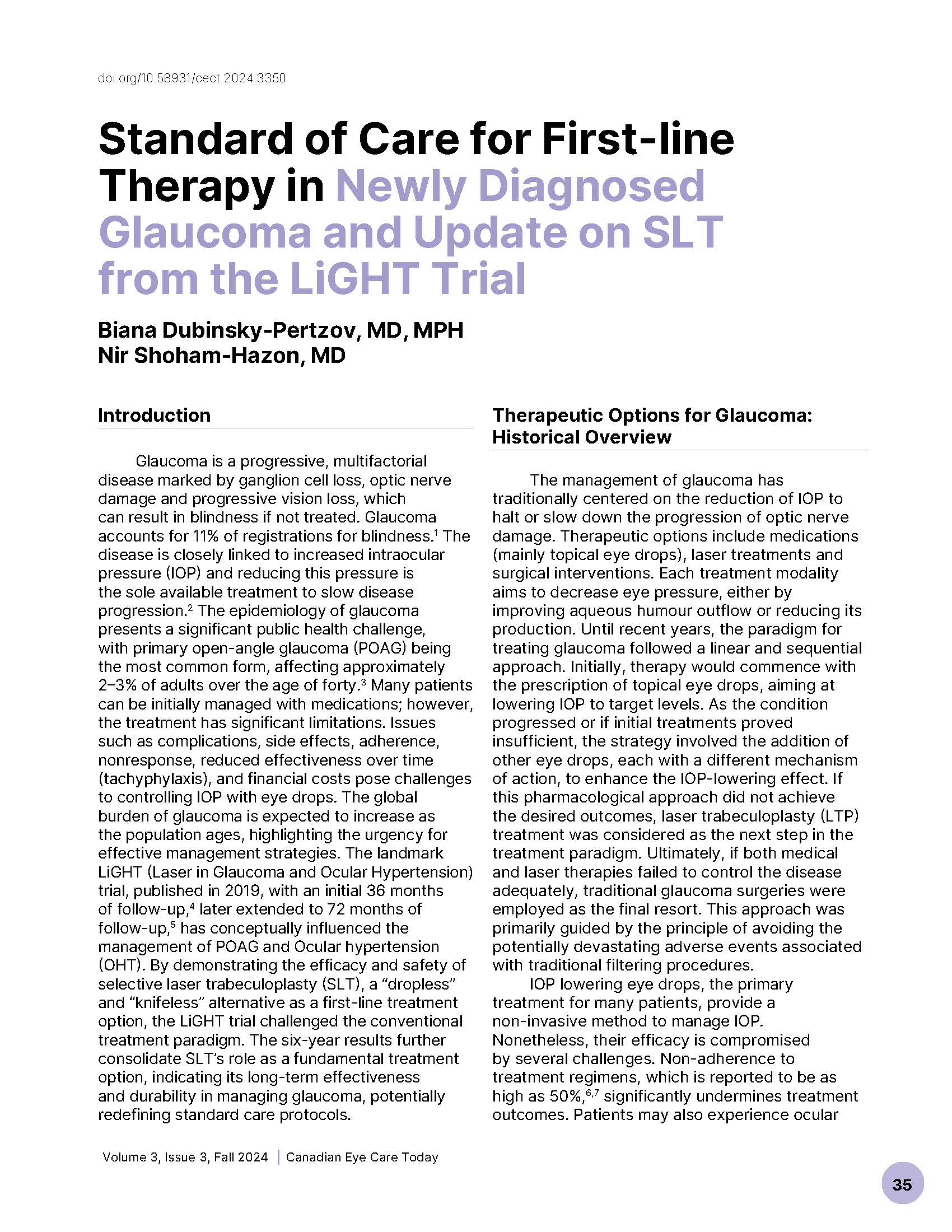Standard of Care for First-line Therapy in Newly Diagnosed Glaucoma and Update on SLT from the LiGHT Trial
DOI:
https://doi.org/10.58931/cect.2024.3350Abstract
Glaucoma is a progressive, multifactorial disease marked by ganglion cell loss, optic nerve damage and progressive vision loss, which can result in blindness if not treated. Glaucoma accounts for 11% of registrations for blindness. The disease is closely linked to increased intraocular pressure (IOP) and reducing this pressure is the sole available treatment to slow disease progression. The epidemiology of glaucoma presents a significant public health challenge, with primary open‑angle glaucoma (POAG) being the most common form, affecting approximately 2–3% of adults over the age of forty. Many patients can be initially managed with medications; however, the treatment has significant limitations. Issues such as complications, side effects, adherence, nonresponse, reduced effectiveness over time (tachyphylaxis), and financial costs pose challenges to controlling IOP with eye drops. The global burden of glaucoma is expected to increase as the population ages, highlighting the urgency for effective management strategies. The landmark LiGHT (Laser in Glaucoma and Ocular Hypertension) trial, published in 2019, with an initial 36 months of follow-up, later extended to 72 months of follow‑up, has conceptually influenced the management of POAG and Ocular hypertension (OHT). By demonstrating the efficacy and safety of selective laser trabeculoplasty (SLT), a “dropless” and “knifeless” alternative as a first-line treatment option, the LiGHT trial challenged the conventional treatment paradigm. The six-year results further consolidate SLT’s role as a fundamental treatment option, indicating its long-term effectiveness and durability in managing glaucoma, potentially redefining standard care protocols.
References
Liu WJ, Taylor LJ, MacLaren RE, et al. Clinical research on the leading causes of severe sight impairment in the UK general and working populations. Clin Ophthalmol. 2023;17:2729-35. DOI: https://doi.org/10.2147/OPTH.S417773
Kass MA, Heuer DK, Higginbotham EJ, et al. The Ocular Hypertension Treatment Study: a randomized trial determines that topical ocular hypotensive medication delays or prevents the onset of primary open-angle glaucoma. Arch Ophthalmol. 2002 Jun;120(6):701-13; discussion 829-830. DOI: https://doi.org/10.1001/archopht.120.6.701
Varma R, Lee PP, Goldberg I, et al. An assessment of the health and economic burdens of glaucoma. Am J Ophthalmol. 2011 Oct;152(4):515-22. DOI: https://doi.org/10.1016/j.ajo.2011.06.004
Gazzard G, Konstantakopoulou E, Garway-Heath D, et al. Selective laser trabeculoplasty versus eye drops for first-line treatment of ocular hypertension and glaucoma (LiGHT): a multicentre randomised controlled trial. Lancet. 2019 Apr 13;393(10180):1505-16. DOI: https://doi.org/10.1016/S0140-6736(18)32213-X
Gazzard G, Konstantakopoulou E, Garway-Heath D, et al. Laser in Glaucoma and Ocular Hypertension (LiGHT) Trial: Six-year results of primary selective laser trabeculoplasty versus eye drops for the treatment of glaucoma and ocular hypertension. Ophthalmology. 2023 Feb 1;130(2):139-51.
Sheer R, Bunniran S, Uribe C, et al. Predictors of nonadherence to topical intraocular pressure reduction medications among Medicare members: a claims-based retrospective cohort study. J Manag Care Spec Pharm. 2016 Jul;22(7):10.18553/jmcp.2016.22.7.808. DOI: https://doi.org/10.18553/jmcp.2016.22.7.808
Reardon G, Kotak S, Schwartz GF. Objective assessment of compliance and persistence among patients treated for glaucoma and ocular hypertension: a systematic review. Patient Prefer Adherence. 2011;5:441-63. DOI: https://doi.org/10.2147/PPA.S23780
Roughead EE, Kalisch LM, Pratt NL, et al. Managing glaucoma in those with co-morbidity: not as easy as it seems. Ophthalmic Epidemiol. 2012 Apr;19(2):74-82. DOI: https://doi.org/10.3109/09286586.2011.638743
Kaur D, Gupta A, Singh G. Perspectives on quality of life in glaucoma. J Curr Glaucoma Pract. 2012;6(1):9-12. DOI: https://doi.org/10.5005/jp-journals-10008-1101
Latina MA, Park C. Selective targeting of trabecular meshwork cells: in vitro studies of pulsed and CW laser interactions. Exp Eye Res. 1995 Apr;60(4):359-71. DOI: https://doi.org/10.1016/S0014-4835(05)80093-4
Lee JW, Chan CW, Wong MO, et al. A randomized control trial to evaluate the effect of adjuvant selective laser trabeculoplasty versus medication alone in primary open-angle glaucoma: preliminary results. Clin Ophthalmol. 2014 Sep 25;8:1987-92. DOI: https://doi.org/10.2147/OPTH.S70903
De Keyser M, De Belder M, De Belder J, et al. Selective laser trabeculoplasty as replacement therapy in medically controlled glaucoma patients. Acta Ophthalmol. 2018 Aug;96(5):e577-81. DOI: https://doi.org/10.1111/aos.13509
Hong BK, Winer JC, Martone JF, et al. Repeat Selective Laser Trabeculoplasty. J. Glaucoma. 2009 Mar;18(3):180. DOI: https://doi.org/10.1097/IJG.0b013e31817eee0b
Garg A, Vickerstaff V, Nathwani N, et al. Efficacy of repeat selective laser trabeculoplasty in medication-naïve open-angle glaucoma and ocular hypertension during the LiGHT Trial. Ophthalmology. 2020 Apr;127(4):467-76. DOI: https://doi.org/10.1016/j.ophtha.2019.10.023
Friedman DS, Nordstrom B, Mozaffari E, et al. Variations in treatment among adult-onset open-angle glaucoma patients. Ophthalmology. 2005 Sep;112(9):1494-9. DOI: https://doi.org/10.1016/j.ophtha.2005.02.010

Downloads
Published
How to Cite
Issue
Section
License
Copyright (c) 2024 Canadian Eye Care Today

This work is licensed under a Creative Commons Attribution-NonCommercial-NoDerivatives 4.0 International License.
